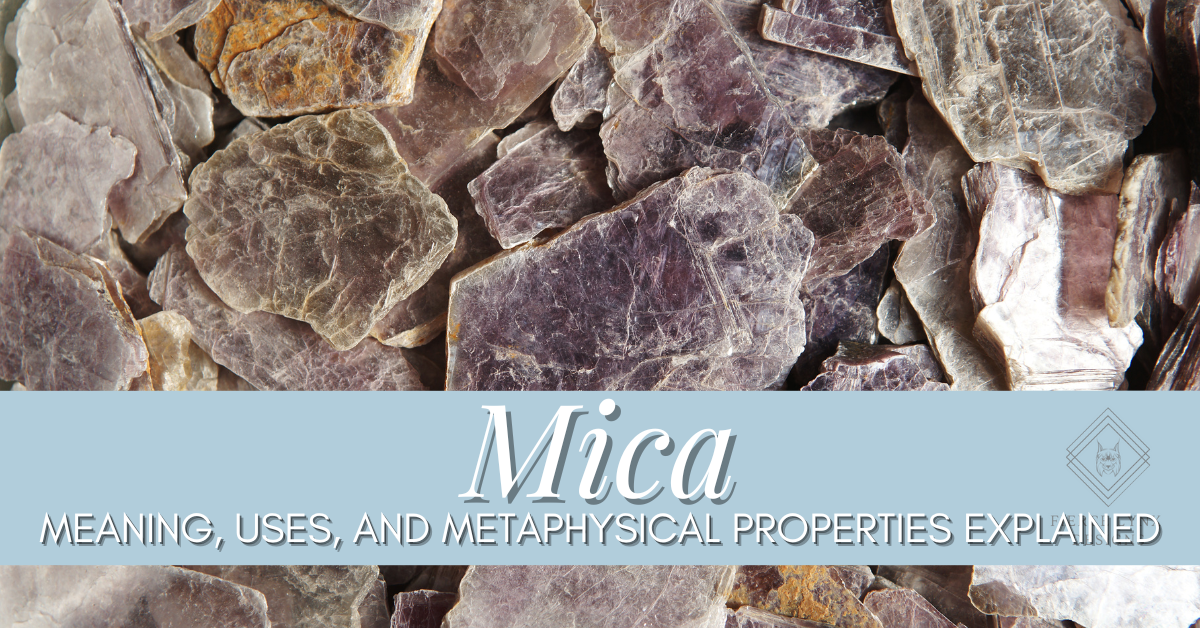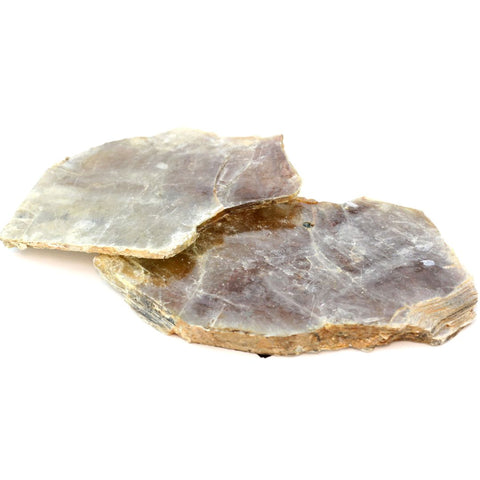
Mica Meaning, Uses, and Metaphysical Properties Explained
In the world of gemstones, the mica crystal isn't the most widely known or sought out. However, it's a strikingly beautiful gem, so it's wise not to overlook its potential in jewelry. Plus, there are far more varieties of mica than most people expect, and each version has a unique look, coloration, or set of features that make the stones highly distinct.
Ultimately, mica is a fascinating material and has uses far outside the world of jewelry and collections. Here's what you need to know about the mica stone meaning, the metaphysical properties of mica, how mica is used, and much more.
What Is Mica?
Mica is a category of silicate minerals that have similar monoclinic crystal structures but varying compositions, though they're often recognized by their flaky appearance. The mica group is large, encompassing a total of 37 different mica minerals.
Broadly, the mica stone is known for its shimmery or sparkly look, which makes them attractive for ornamental applications. In fact, the name "mica" is derived from "micare," the Latin word for "shine."

Generally, the most common versions of mica are purple lepidolite, black biotite, brown phlogopite, and clear muscovite. Each one has unique features, though broadly fits in the mica category. For example, lepidolite is lithium-bearing, separating it from most other forms of mica.

However, while those mica variants are the most widely used in the world of jewelry, they just scratch the surface of the world of mica.
Mica Physical Properties
When it comes to the physical mica properties, the various versions of mica are characterized by their distinct layers, creating an internal sense of depth. Plus, the layers are easy to split, allowing thin sheets of mica to be turned into sheets or flakes for various applications and purposes.

Overall, mica is classified as soft, ranging from a 2 to a 4 on the Mohs hardness scale, depending on the subtype and exact specimen in question. That means it's often easy to scratch, cut, shape, or manipulate, though the precise degree can vary. Additionally, they can have a pearly to vitreous lustre and range from translucent to opaque.
When it comes to colours, the mica crystal properties and varying compositions lead to a rainbow's worth of hues. Neutrals like grays, browns, and whites occur, as well as striking shades of purple, rose, green, red, yellow, and more. Plus, there are colourless versions. Due to the compositional mica stone properties, the stones typically have a white or colourless streak.
What's critical to note is that each type of mica has varying chemical and mineral compositions. As mentioned above, lepidolite contains lithium, and that's not characteristic of the entire mica group. Phlogopite is known as magnesium mica due to a greater presence of magnesium, while biotite is often iron-rich.
However, it's these varying compositions that can result in a wide array of colours, as specific minerals can alter the hue of a stone. For example, lepidolite gets its purple hue from manganese. The high iron content in biotite leads to darker colours, such as black and deep brown.
How Is Mica Formed?
Mica is largely found along with igneous and metaphoric rocks, including pegmatite masses, though it can occur alongside sedimentary rocks, too. A variety of processes and conditions can lead to mica stones. In some cases, volcanic activity involving magma or fluids can lead to deposits of materials that become mica.
The weathering of certain minerals – including feldspar – may also play a role in the formation of specific mica gemstones. Additionally, some versions form on the seafloor due to clastic sedimentation.
When it forms, most micas occur as irregular tabular masses or thin flakes or plates. However, larger mica crystals can happen, and due to their flaky structure, they're often referred to as books when they occur.

Sometimes, mica forms as rosettes, a layered look resembling petals coming off flowers. Those commonly become collector's stones, as other applications usually require cutting or shaping, destroying that particular formation's natural beauty.
Where Is Mica Found?
Mica is found worldwide, but most mined mica comes from India, particularly from Bihar and Madras. Along with being prevalent in those regions, low labour costs make the country ideal for managing the cost of the related operations.

However, there are a few other notable producers of mica. Belgium, Brazil, China, and Madagascar also mine mica regularly, though the mica from those nations is less present in the broader market.
Additionally, many other countries are known to have mica. The trick is that they may not have sources that are large or accessible enough to justify mining or may only maintain smaller mining operations when compared to the nations above. Still, just because a mica gemstone comes from a country other than those listed doesn't mean it isn't authentic.
Mica Uses and Benefits
Mica has a wide variety of uses. While most people focus on mica gemstones in jewelry or as part of collections, it serves various industrial purposes, too. Mica offers excellent thermal resistance. Plus, it's chemically inert, water-resistant, lightweight, and has outstanding dielectric strength.
As a result, mica is often used in insulation products. It's a component of heat shields for various aerospace vehicles, such as shuttles. You'll also find it in electrical and thermal insulation, flame retardant barriers, and flight recorder insulators in spacecraft.
Similarly, mica is found in insulation products in many vehicles, including gasoline-powered and electric versions and home appliances. It's a sheetrock component and can be a filler in specific rubber and plastic products. Ground mica may also be found in drilling mud.

It's common to find micas in paints and pigments, too. The mica can brighten certain colours or create a glittery quality within the paint and pigment. Since mica is shimmery, it also makes its way into cosmetics and skincare products.
When people think of mica crystal benefits, they usually refer to the mica spiritual properties. While the exact uses vary, many view mica as a protective stone. Some also feel that the reflective qualities allow it to deflect negative energy. Many also consider it a calming gemstone, so some use it to restore a sense of harmony or balance.
In this regard, mica is used in several ways. Some choose to wear the stone in a piece of jewelry as a means of bringing any potential mica benefits with them. Others prefer to meditate on the gem, using it as a point of focus for a spiritual practice or journey. Displaying the crystals can also work as part of a spiritual practice, particularly among those who create altars.
At times, mica becomes part of pendulums, too. The related use typically involves some degree of divination or answering challenging questions. In that regard, a protective or balancing stone is a popular addition to a pendulum, particularly when seeking guidance on difficult matters.
Mica in History

Mica has long been a useful stone, and its use dates back to ancient times. Egyptians, Greeks, Indians, and Romans were all known to leverage mica, as well as ancient Chinese civilization, Aztecs, and many others.
There's even evidence of mica in cave paints created during the Upper Paleolithic period. The earliest hues discovered were red and black, and there are some examples of white drawings, including mica.
In the Southwestern United States, mica played a role in indigenous pottery, and the Picuris Pueblos and Taos continue using mica for that purpose today. Mayans added it to clay and stucco to make templates shine in the sun.
In Pakistan, mica added a glittery quality to women's clothing, particularly during the summer. There – along with in Bangladesh and India – mica powder also decorated pottery to make it sparkle.
Mica powder is also present in Japanese woodblock prints, primarily to make the image glitter. There are also examples of it being used in pottery.
There are also ancient medicinal practices that involve mica. One example comes from Ayurveda, where mica was said to assist with treating respiratory or digestive diseases or issues.
Mica Metaphysical Properties
The metaphysical properties of mica can vary dramatically depending on a person's belief system and the exact type of mica involved. Some feel the mica spiritual meaning focuses on reducing or eliminating nervous energy or hostile energy. It's generally considered a protective stone, too.
However, the mica rock meaning can change if you're looking at a specific type of mica. For example, the lepidolite mica crystal meaning focuses on calmness, clarity, and harmony, and since it's purple, they connect it to the crown chakra.

The green mica crystal meaning – which usually involves the meaning of fuchsite since it's green – aligns with the heart chakra instead and is often associated with compassion, love, and rebirth.
When it comes to mica crystal healing properties, those can also vary depending on the type of mica. However, many broadly believe that it can bring balance to the body and chakras, levelling out a person's energetic system. The mica stone healing properties are also associated with anxiety and emotional stress reduction, leading to increased emotional stability.
Some also feel that mica can assist with a variety of ailments. For example, some think it can relieve insomnia and decrease muscle pain. Others believe it can address skin inflammation or rashes and promote healthy cell regeneration.
Many even feel it can help in the battle against an eating disorder, leading to a better relationship with food. One of the green mica healing properties potentially counters that, as some think that the stone can reduce hunger when fasting or cleansing, which potentially isn't conducive when dealing with specific eating disorders.
However, it's critical to note that any healing benefits of mica – including the ability to prevent or treat a condition of any kind – aren't scientifically proven. As a result, holding, wearing, or meditating on mica isn't a substitute for legitimate medical care. Instead, getting guidance from a healthcare professional if you're experiencing any health concerns is essential.
Mica in Jewelry

While mica has many industrial uses, the mica gemstone is highly popular for jewelry. However, since its appearance can vary significantly from one specimen to the next, jewelry featuring it won't usually end up in chain stores. With chains, consistency is critical. Additionally, the ability to repeat a design at scale is often a must.
Fortunately, independent jewelry designers can take advantage of beautiful mica gemstones. They have an easier time supporting small runs or one-off pieces, allowing them to celebrate the amazing look of mica without the drawbacks that chains face.
Generally, mica isn't faceted for jewelry, as its structure and lack of full transparency make it ill-suited to faceting. Instead, mica is more often shaped and polished or used to create cabochons, and it's also commonly turned into beads. Some pieces may even feature raw mica.
It's also common to find mica in pendulums designed for various spiritual or divination practices. Often, these include beads or polished stones, though some may feature cabochons or raw mica crystals, too.
Stones Similar to Mica
Generally, not many stones are similar to mica. One reason is that the shimmering quality characteristic of many types of mica found in other gems is actually the result of mica. For example, aventurine – a kind of green quartz – has a shimmer that's referred to as aventurescence, and it occurs due to mica inclusions.
Mica can also end up as inclusions in other types of quartz, imbuing the quartz with a shimmery quality. The same can occur with fluorite crystals and many other gemstones. Sparkly granites can contain mica, too.
Goldstone is known for its glittering quality, as well. It's a manufactured stone that includes coloured glass with metallic inclusions, usually made of copper, chromium, manganese filings, flakes, or granules.
In some cases, stones known for a metallic lustre may also resemble specific micas. For example, pyrite –commonly referred to as fool's gold – is a mineral known for its metallic appearance. Chalcopyrite can also have a metallic quality, leading to a shimmer.

